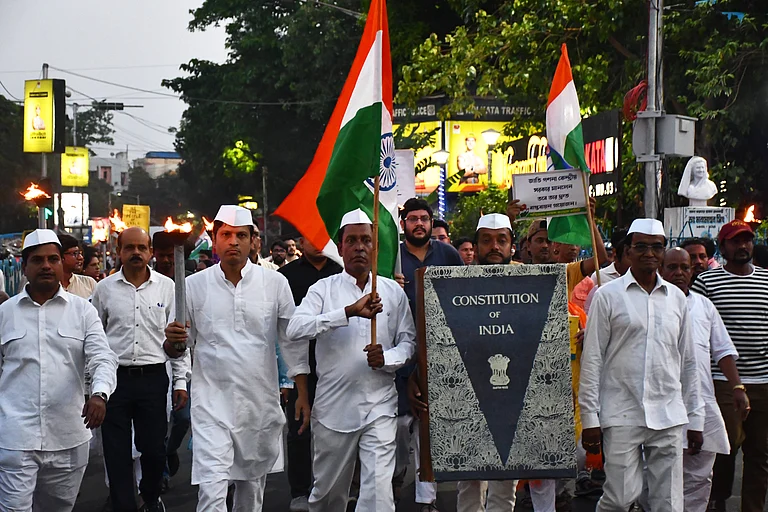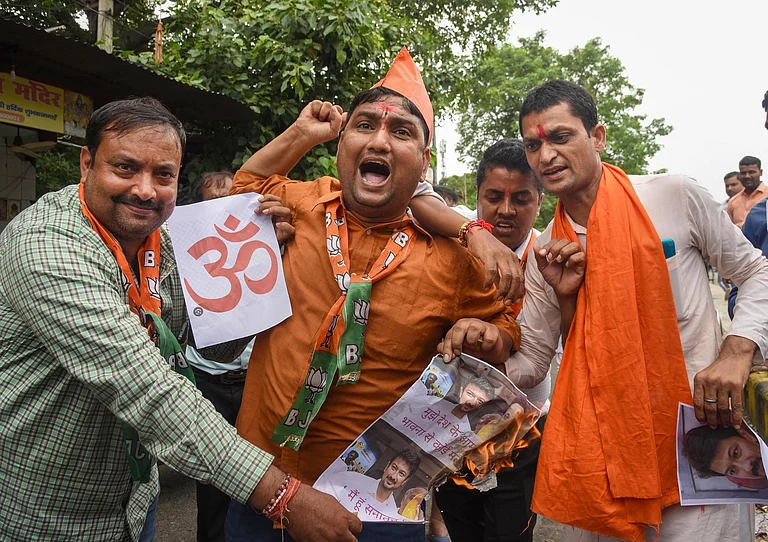With a population of over 3 million, Manipur, the 'Land of Jewels', is home to the Meiteis, Pangals, Nagas, Kukis, Zomis and several other tribes that speak a Sino-Tibetan language. These tribes follow various faiths and have lived together for centuries. In October 2021, however, the construction of a structure relating to Govindji temple by the BJP-led state government in Sana Kongyung, erstwhile Royal Palace of Independent Kingdom of Manipur, led to a controversy. The police had to detain a number of members of Pandit Loishang, the religious body of the Sanamahi faith, who started a demonstration against the construction at a site where Ibudhou Pakhangba, a primordial serpentine dragon, Ibudhou Nongsaba, a lion-like dragon God, and Ima Yumjao Lairembi, Mother Goddess of the Meitei mythology have been worshiped since time immemorial.
Talking to Outlook, Ranjit Meitei, Secretary of Pandit Loishang, said, “Sanamahi is a 2000-year-old indigenous faith. Inside the Royal Palace, we have two sites. One is for Govindaji temple and the other site is for Sanamahi. But a structure relating to the temple is built recently on the site of Sanamahi. It does not have any relation with the faith. We have filed a case in the court against it.”

The Manipur Congress termed the incident a blasphemous attack against the ancient Meitei Sanamahi religion by the BJP Government in Manipur.
In nearby Tripura, another BJP-led state, a clash erupted between the CPI (M) and the BJP in 2018, over the plan of constructing a Ram Temple at a site where a column of Mohini Tripura, a CPI(M) martyr, was supposed to be constructed.
While such incidents have intensified after the BJP formed governments in Northeast states, several decades before the party formed the government in Assam, the RSS had set foot in Assam. Senior RSS pracharak Ram Singh Thakur arrived in Assam in 1946 and soon the second set of pracharaks opened RSS shakhas in Guwahati, Shillong (then a part of Assam) and Dibrugarh. Since then scores of RSS cadres started thronging the state, silently carrying forward the Hindutva agenda in a region with ethnic and linguistic diversity.
The first job they took up was providing major relief work after the 1950 earthquake in the state. The following decades have seen the establishment of Vivekananda Kendras, Ekal Vidyalaya and Vidya Bharati (educational wing of RSS). The Vishwa Hindu Parishad, affiliated with the Sangh Parivar, also opened hostels for students and sent them to a residential school of Rajasthan’s Banswara as part of its programme Banswara Pariyojana.
Seva Bharati, another RSS affiliated organisation works in the tribal and Adivasi dominated pockets like tea garden areas of the state, and provide free education, health facilities and vocational training.
The RSS also started establishing connections with the Bengali, Bihari and Marwari business communities in the state.
However, its friction with the local population began when the Assam Movement by the All Assam Students’ Union (AASU) started to deport illegal settlers in the early 1980s. The RSS deployed its students’ wing Akhil Bhartiya Vidyarthi Parishad (ABVP) to support the Assam movement and to turn attention to illegal Muslim settlers.
RSS’s goal turned into a reality after 35 years when Assam passed the Citizenship Amendment Act to give shelter to refugees other than the Muslims, a step vehemently opposed by the AASU citing a violation of the Assam Accord 1985.
The RSS made inroads into the tribal-dominated Northeast because of the internal tension of these tribal societies. These tensions are used in an advantageous way by RSS and its affiliates, says Kaushtabh Deka, a political scientist and Assistant Professor at Assam’s Dibrugarh University.
“Most of the tribal societies in Northeast are still going under transition, although sometimes we kind of believe that because of modernisation, education, conversion to other religion is more or less completed. The RSS could successfully identify their agenda with the claims and demands of those groups who perhaps are talking about indigenous religion, who perhaps somehow feel that their original faith system has been neglected and feel marginalised within the community etc," Deka tells Outlook.
Deka’s statement can be supported by multiple examples in which RSS has been seen trying to get into the tribal societies of Northeast with its Hindutva agenda but somewhat with a softer version of it by incorporating tribal symbols, faiths and languages into its central idea.
For instance, the BJP before the 2017 Tripura Assembly election, gave ‘Bharat Mata’ a tribal look. Instead of the usual saari, Bharat Mata was depicted in customised tribal attire of four major tribal communities Debbarma, Tripuri, Tripura, Reang and Chakma, which together constitute 77.8 per cent of the total tribal population in the state.
“The idea is to counter the sense of alienation these tribes feel from the rest of the country. They too are a part of Bharat and Bharat Mata is theirs too,” says Sunil Deodhar, the then BJP in-charge for Tripura. The party won the polls which had so far been a red bastion for decades.
In Nagaland, where over 87 per cent of the population follows Christianity, Prime Minister Narendra Modi in December 2014 became the first Prime Minister to have inaugurated the Hornbill Festival. In his debut visit to the tribal state, Modi dressed in traditional attire and departing from his normal practice of speaking Hindi, addressed the jam-packed crowd in English where Hindi is still quite an alien language. The striking part of his speech was when he encouraged the people to chant Kuknalim which means Victory to Nagalim/Nagaland instead of Jai Hind (Victory to India). This is five months after Padmanabha Balakrishna Acharya was appointed as Governor of Nagaland, an RSS leader and former President of ABVP.

When BJP first set foot in Nagaland in 2012, the party was criticised for its allegiance to Hinduism in the Christian dominated state. However, the BJP started glorifying Rani Gaidinilu, an anti-Christian Naga woman leader and an advocate of indigenous faith, who fought against the British to protect the Naga-dominated territories. In 1930 she had even raised a three-tribe Zeliangrong army against the British to establish Naga Raj, and resist the Nagas' conversion to Christianity.
Notably, Rani Gaidinilu had advocated for a separate Zeliangrong territory within the Union of India and fought against Kevi Yalay Phizo’s Naga National Council (NNC) that wanted a separate Nagalim out of the Indian Union. For the BJP, Rani Gaidinilu is the perfect face that chimes with the idea of ‘Akhand Bharat’.
In Arunachal Pradesh, the home to 26 tribes and over 100 sub-tribes, soon after forming the government, the BJP created a Department of Indigenous Faiths and Cultural Affairs. The Department has started codifying and formalising faiths like Donyi-Polo, Amik Matai, Nani-Intaya and Rangfrah to create a front against the Christians. An interesting aspect of the formalisation of the religions is the construction of Hindu deity look-a-likes. Until a few years ago Rangfrah, a spirit worshipped by the animist Tangsa tribe of Arunachal Pradesh, did not have a form. But now Rangfrah has a Shiva-like form with a Mongoloid white face.
“In a way, they (BJP) are trying to revive and protect and support the indigenous faiths, but perhaps they are in a subtle way trying to change the very nature of worship. This is inevitable also because whenever these well-organised religions come in touch with small faith systems; certain kind of manipulations or appropriations is natural," Deka adds.
However, Tajom Tasung, President of Indigenous Faith and Culture Society of Arunachal Pradesh said that the assumption of tweaking indigenous faith practices with elements of Hindutva is baseless. Tasung, whose organisation is working towards the formalisation of Donyi-Polo, said, “The indigenous faiths come under the Sanatana Dharma. So, we have a lot of similarities with the Hindu religion. While we codify it, it looks like we are inserting Hindu rituals but this is not true. Like offering prayers by lighting a candle might look like a Hindu ritual, but traditionally we have been praying by lighting a fire.”
He said, his organisation has been actively working in the Nyshi belt (a tribal belt) of Arunachal Pradesh including the capital Itanagar, Papum Pare, West Kameng and East Kameng and Lower Sunbansiri district. According to him, codification and formalisation of the indigenous faith is the need of the hour in the light of growing Christian activities in this belt.
In Manipur, BJP Chief Minister N Biren Singh drew flak for distorting the history of the state to propagate the Hindutva Ideology of RSS. At Madhabpur Mela, a government-sponsored programme organised in Gujarat to recreate the mythical elopement and wedding of Rukmini and Lord Krishna, where Rukmini was presented as a woman from the Idu-Mishmi tribe of Arunachal Pradesh, the CM said, “During the time of Lord Krishna, there was no separate Arunachal Pradesh or Assam or Manipur. The entire Northeast was one entity. Arunachal Pradesh, Manipur and Nagaland are bordering China, Lord Krishna made them part of India during his time.” This statement drew huge criticism from student organisations and opposition parties of Manipur accusing the CM of promoting Hindutva in a region with an entirely distinct cultural and social identity.
In another event, the RSS in the state came under severe censure for placing a portrait of ‘Bharat Mata’ between two local heroes of the Ango-Manipur war of 1891.
Notwithstanding such occasional controversies, the promotion of Hindutva in Northeast states has mostly been smooth.
“Even the most staunch, conservative tribal societies otherwise having lots of reservations about Hindutva have started to differentiate between RSS’s Hindutva and 'aggressive Hindutva'. Most of them believe that the RSS is just a reformist and cultural body that talks about education and health. The RSS is downplaying their hardcore Hindutva line in Northeast India to keep the tribes happy”, said Kaushtabh Deka.


























